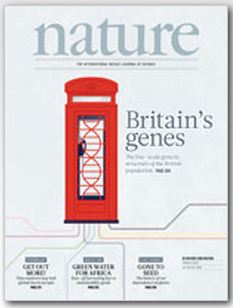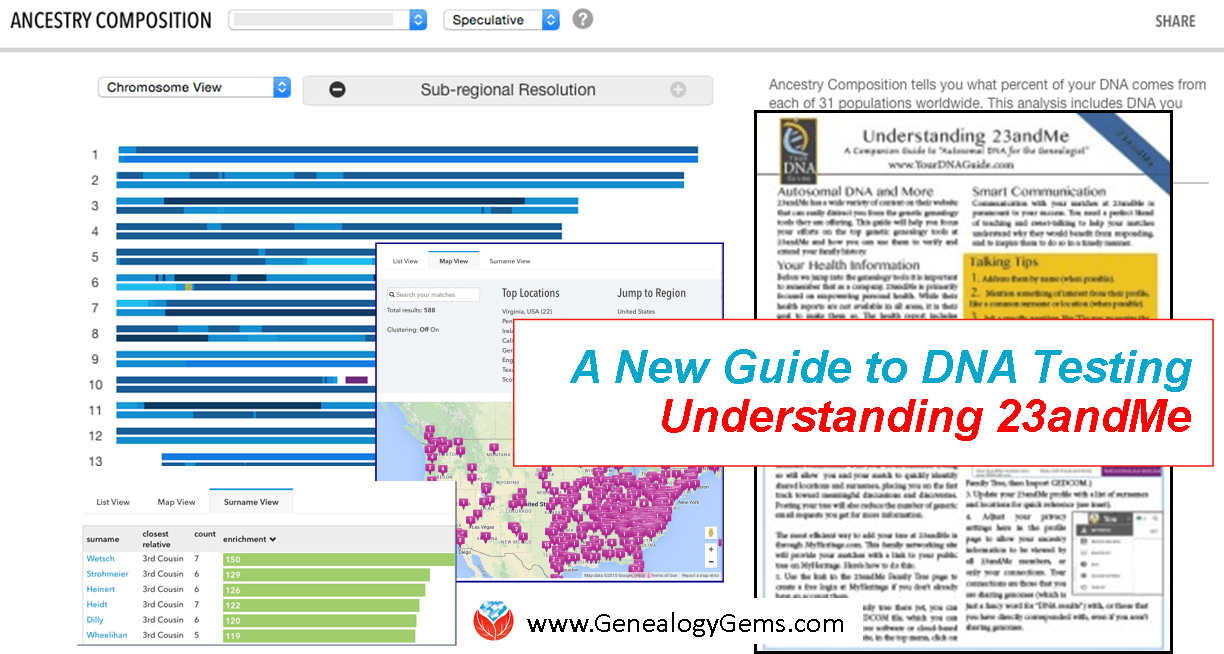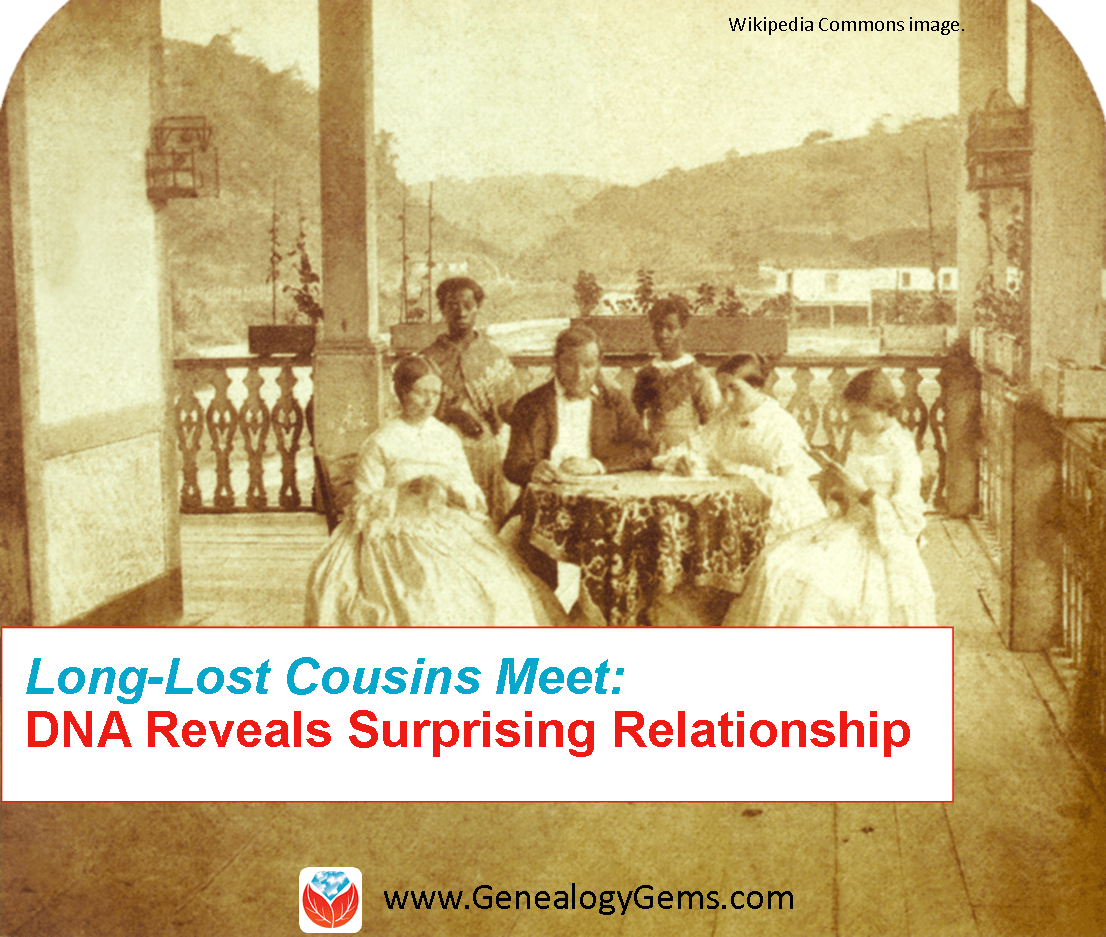by Lisa Cooke | May 7, 2015 | 01 What's New, British, DNA

The key to learning about our ancestors from our own DNA is to have a lot of people tested who can all trace their ancestry to a specific geographic location. A groundbreaking scientific study has just been published in Nature by Stephen Leslie and colleagues that details the origins of the people of the UK. (Read the abstract here.) This study has ramifications for you, as a genetic genealogist, even if you don’t have origins in the UK.
Dr. Leslie and colleagues collected data from 2,039 Britons of European ancestry who lived in rural areas and knew that their four grandparents were all born within 80 kilometers (50 miles) of each other. This means that their DNA should accurately represent the DNA of individuals living in that area in the late 1800s. Using multiple fancy and advanced statistical methods, the researchers identified 17 distinct genetic groups. When they overlaid these groups on a map of the UK, what they found was remarkable. Each genetic group, with few exceptions, mapped to a very specific geographic location.
The largest cluster by far, encompassing half of those tested, maps to Central/South England. Well, the first serious settlers of Britain were from the Roman Empire whose influence in 43 AD at the time of their entry into Britain was extensive, from Spain to France to Italy to parts of the middle east and North Africa. Then around 450 AD the Angles, from modern day northern Germany and southern Denmark, and the Saxons, from Germany, invaded. According to linguistic and archeological evidence, the previous Roman culture was basically wiped out. But were the actual people destroyed, or just their culture?
To find out, the team compared the UK samples with 6,209 people from continental Europe to understand their ancestors’ contributions to Britons’ ancestry. According to the DNA evidence, the descendants of those first Roman settlers are still very much alive. In fact, the paper reports that Saxon ancestry in Central/South England is very likely to be under 50%, and most likely in the range of 10–40%, with instead a large portion of the genetics now being attributed to France and by extension, the Roman Empire.
Another interesting finding: the Viking conquerors were nearly genetically absent in most of the UK.
Very unfortunately, this data on DNA in the UK will not be a part of the reference samples at your genetic genealogy testing company. But it does demonstrate unequivocally that THIS WORKS! DNA testing can help us trace our ancestral origins and thanks to improved techniques and larger data sets, we have much to look forward to. Dr. Peter Donnelly, population geneticist at Oxford and co-author of this paper said, “History is written by the winners, and archaeology studies the burials of wealthy people. But genetic evidence is interesting because it complements that by showing what is happening to the masses rather than the elite.”
Learn more about DNA testing for family history with my Getting Started in Genetic Genealogy Quick Guide, available now in the Genealogy Gems store. In fact, I have a whole series of Guides there on using DNA for genealogy. Check them all out!
If you’re ready for some one-on-one consulting to see what DNA can tell you about your family history, visit my website to learn more.
by Lisa Cooke | Oct 29, 2015 | 01 What's New, DNA
Over a million people have done DNA testing with 23andMe, many lured by that company’s health information tools. Learn to use their genetic genealogy tools to get  the most out of testing there! (and keep reading for a special limited time sale!)
the most out of testing there! (and keep reading for a special limited time sale!)
I am one of the million+ people who have tested my DNA with 23andMe. Early on in my days as a 23andMe customer, I spotted a match who listed ancestry from Washington state, where I grew up. Because I have had both of my parents tested, 23andMe told me that this match was on my dad’s side. I sent an inquiry out to the match and named a few of my paternal surnames as possible connections between us.
As it turns out, this match was my dad’s half first cousin! They are about the same age and had played together all the time as boys, but their families had lost touch over the years. What was even more exciting for me, is that using the tools at 23andMe I was able to see the actual physical locations on the DNA that I shared with this cousin.
Knowing that our common ancestor was Lucy J. Claunch, I knew that these actual physical, tangible pieces of me were once pieces of her. All at once I felt a discernible shift in myself and the way I viewed my connection to her. She was no longer a name on a genealogical record, she was my ancestor, and I wanted to know more. For me, it took the DNA connection to give me that added oomph to turn my genealogy into family history. As it happened, that DNA connection came through 23andMe.
How to Focus on Genealogy DNA testing with 23andMe
23andMe is primarily focused on empowering personal health. They recently announced the restored ability to provide limited health information to their customers. The wide variety of content on their website can easily distract you from the genetic genealogy tools they are offering. To help you focus on these tools and use them to verify and extend your family tree, I’ve just released a NEW laminated quick guide, Understanding 23andMe.
 Understanding 23andMe addresses the most pressing genetic genealogy questions for those doing DNA testing with 23andMe, like:
Understanding 23andMe addresses the most pressing genetic genealogy questions for those doing DNA testing with 23andMe, like:
- How can I control how much information is being shared with others?
- How can I enter my genealogical information?
- How do I know when I have a good match?
- Is the YDNA and mtDNA information they give the same as what I see at other places?
- What is the best way to use the ethnicity results presented?
Purchase this guide NOW in the Genealogy Gems store and you’ll SAVE BIG! It’s only $5.95 right now–regularly $8.95! You’ll also save if you buy it with a super bundle of my entire series of DNA quick guides–7 of them now to help you “do your DNA” right from start to finish!
More DNA at Genealogy Gems

A family and its female slave house servants in Brazil, c.1860. Wikimedia Commons image. Click to view full source citation.
We’re Cousins? DNA for Genealogy Reveals Surprising Relationship
DNA Confirms Presidential Love Affair 90 Years Later
Confused by Your AncestryDNA Matches? Read This Post
by Diahan Southard | Oct 24, 2014 | 01 What's New, Ancestry, DNA, Jewish
 Ancestry.com has improved the ability of AncestryDNA to find good matches for Jewish, Hispanic and other ancestries that maybe weren’t so precise before. Here’s the lowdown, quoted liberally from Ancestry.com’s press release:
Ancestry.com has improved the ability of AncestryDNA to find good matches for Jewish, Hispanic and other ancestries that maybe weren’t so precise before. Here’s the lowdown, quoted liberally from Ancestry.com’s press release:
The problem: Predicting genetic relatives among customers of Jewish and Hispanic descent and some other groups. “In DNA matching, we are looking for pieces of DNA that appear identical between individuals,” says the release. “For genealogy research we’re interested in DNA that’s identical because we’re both descended from a recent common ancestor. We call this identical by descent (IBD). This is what helps us to make new discoveries in finding new relatives, new ancestors, and collaborating on our research.”
“However, we also find pieces of DNA that are identical for another reason. At one extreme we find pieces of DNA that are identical because it is essential for human survival. At the other, we find pieces of DNA that are identical because two people are of the same ethnicity. We call these segments identical by state (IBS) because the piece of DNA is identical for a reason other than a recent common ancestor. This, we have found, often happens in individuals of Jewish descent.”
“The challenge in DNA matching is to tease apart which segments are IBD, and which ones are IBS….Most Jewish customers find that we predict them to be related to nearly every other Jewish customer in the database….Detecting which cousin matches were real and which ones were bogus has always been a challenge for these populations.”
First step toward a solution: “By studying patterns of matches across our more than half a million AncestryDNA customers, we found that in certain places of the genome, thousands of people were being estimated to share DNA with one another–likely a hallmark of a common ethnicity. Our scientific advancements… have allowed us to effectively “pan for gold” in our matches–by throwing out matches that appear to only be IBS, and keeping those that are IBD.”
“While the problem was more pronounced in customers of Jewish and some Hispanic descents, we observed this problem across all ethnic groups. So, all customers will see increased accuracy of their DNA matches, and significantly fewer ‘false’ matches.”
AncestryDNA results with better matches found by this method “will be available in the coming months,” says the release. They plan to email existing customers when results are ready.


 the most out of testing there! (and keep reading for a
the most out of testing there! (and keep reading for a  Understanding 23andMe
Understanding 23andMe
